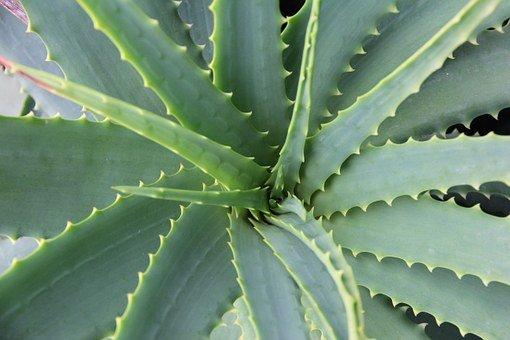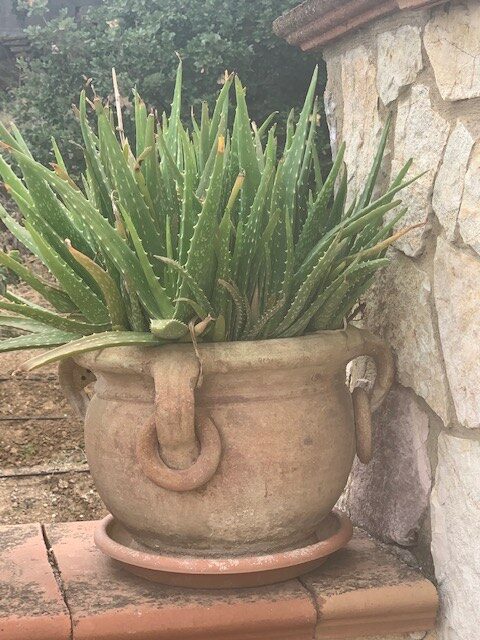The Aloe Vera is a beloved and popular houseplant that is easy to care for. It does present one challenge, however. It can become leggy during growth. Why do you get leggy aloe vera?
There are many reasons that can lead to the development of leggy aloe vera plants. A couple of the most common reasons are that the plant has been overwatered and fertilized too much.
This article will cover the various reasons why an aloe vera plant will become leggy and ways to fix the leggy growth.
- Related article: Proper Care of Aloe Plant
Why Is My Aloe Vera Leggy?
When your aloe vera plant begins to stretch and look leggy, it’s tell you that it has a problem. There are a variety of reasons that an aloe vera can become leggy.
The most common causes will include too little light, too much water, or too much fertilizer. It’s important to understand what is distressing your plant to be able to intervene on its behalf.
The leggy plant process is known as etiolation, when a plant stretches for light, water, or warmth. It signifies that these fundamental environmental requisites are out of reach.
1. Overwatering
The aloe vera is a succulent, so it does not need that much water to survive. These plants store moisture in their fleshy leaves for future needs. Excessive watering can cause an aloe to go into shock, causing the aloe’s legginess.
To prevent leggy aloe plants, allow the soil bed’s top two inches to dry before watering anew.
Learn more about Caring for Overwatered Aloe Plants.
2. Improper Temperature
The aloe vera prefers an environmental temperature range between 55° and 80°F. If you place your plant in direct sunlight, chances are at some point the temperature will exceed 80°F.
The plant may extend its leaves in all directions to compensate for the excessive heat and look for cooler air.
3. Insufficient Light
This is the most common cause for aloe plants to become leggy. Your plant will begin to stretch toward a light source to obtain enough light for its survival. It is a commonly found condition in indoor houseplants.
If your plant is receiving too little light, it will survive but also lose its vibrant green color. Foliage can even turn white. A vivid green color signifies that your plant can successfully photosynthesize for nourishment.
4. Over-Fertilization
The aloe vera plant requires very little feeding. It is not a big eater. Keep in mind that it may only require a single annual feeding at the beginning of the growing season in the spring.
Should you overfeed your aloe, it will not improve plant growth. On the contrary, you risk burning roots and leaves, causing it to appear leggy.
As a slow grower, the aloe does well with nutrients that are already in the soil bed. If you want to feed your plant, avoid fertilizers, and choose a rich fertile soil instead or mix in compost.
5. Small Container Size
If the aloe vera’s container is too small, growth will be leggy. In this case, the root system will not have sufficient room for growth, and your plant will become leggy. The aloe is a very adaptable succulent, but will require repotting when it outgrows its pot.
Keep an eye out and repot the aloe plant into a new pot that’s one to two sizes larger than its current pot.
6. The Container Is Overcrowded
If an aloe plant is overcrowded in its container, it’ll become root bound and have leggy growth. If your plant does not have sufficient space, its stems will become elongated.

How to Fix Leggy Aloe Vera
If you don’t like the leggy look of your plant, here are several methods for fixing this.
1. Prune Your Leggy Aloe Vera
Trim any excess growth. By pruning your aloe back, you will stimulate new, bushier growth. Immediately after you have trimmed it, it may have a rather bedraggled appearance, but you’ll see improvement in no time. Always trim off mushy, sickly, or dead foliage.
2. Change the Plant Container
Choose a new container that is at least one inch larger than the plant’s root ball. Always opt for a wider, but shallower container, as root systems are not very deep.
3. Repot Your Aloe Vera Plant
Repot your aloe in fresh fertile soil. If your plant is rootbound or overcrowded, it will need repotting. It may also have consumed most of the nutrients in its soil bed already. Providing your plant with fresh fertile soil mix for cacti and succulents will make all the difference.
4. Provide Your Aloe Vera with Sufficient Light
To prevent an indoor aloe plant from stretching its leaves, provide it with at least 6 hours of daily sunlight. This succulent thrives in warm sunny weather. However, avoid placing it in direct sunlight.
Too much direct sunlight exposure can harm the aloe vera leaves. The foliage of outdoor aloe plants is at risk for sunburn. When cultivating outside, use containers as this will leave you free to move them as necessary.
5. Adjust the Environmental Temperature
To encourage the growth of indoor aloe vera plants, you may want to increase the indoor temperature. In the event of your aloe becoming leggy, you will want to do the opposite. By lowering the temperature, plant growth will slow. Set your room temperature cooler, but between 55° and 80°F.
If the temperature goes higher, leggy growth will occur. If you do not have a thermostat, install a temperature monitor with an alarm that triggers if the temperature drops or rises above desired levels.
How to Prune Leggy Aloe Vera
Pruning a leggy aloe vera is not hard. Follow these steps on how to prune aloe vera:
- If you wish to prune your aloe vera plant, begin by inspecting it. It’s important to evaluate if the plant is leggy on one side only, or if the entire plant is leggy. Also look for brown tips or dead foliage, so you can remove these too.
- Prepare a sterile garden knife and sterile pruning shears for trimming. Make sure you use a sharp knife to make clean cuts.
- Snip off all dead and damaged foliage. Remove leggy stems and any aloe leaves that have brown tips as these are infected. You can use shears or a knife to make clean cuts depending on the size of leaves. Clean cuts enable the plant to grow new healthy leaves from the cut point.
- Clean the plant wounds. Cuts should not be exposed to dirt, water, or the soil bed as this can cause fungal infection.
- To encourage recovery after pruning, remove any offshoots or aloe vera pups, as these use energy that the plant needs for recovery.
- Repot your aloe plant in fresh fertile soil.
- Water your plant with filtered water after pruning and repotting has been completed.
How to Repot Leggy Aloe Vera

After pruning, it is a good idea to repot your aloe vera plant in fresh soil mix. You can also choose a new pot for repotting. A terracotta pot is a good choice because the container drainage holes are usually pretty good.
Follow these repotting steps to promote healthy growth of aloe vera:
- Gently remove your aloe plant from its old container.
- Delicately remove old soil from the roots.
- Inspect the roots for signs of fungus or disease.
- If root parts are infected, remove them. Also, remove oversized roots by trimming them.
- Fill a new container partially with fresh potting soil specifically for cactus and succulents.
- Position your newly pruned aloe in the new container.
- Fill in the container with the remaining fresh soil mix.
- Water so that the soil is evenly moist, but not soggy.
- Place the newly repotted plant in bright indirect sunlight.
- Always keep the soil moist.
Leggy Aloe Vera Plant Final Thoughts
The leggy appearance aloe veras can occur, but they are easy to fix and care for. However, if you notice that your plant is growing leggy, then you need to take action immediately. Use the guide above on how to fix leggy aloe veras.
Learn more about caring for aloe offshoots and your aloe vera plants, check out these articles for this popular plant:

